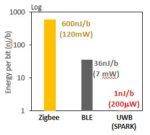The new 5G C-band service is now up and running in the U.S., and subscribers are finally starting to see some of the promise of 5G. The new C-band services are primarily in spectrum allocations between 3 and 4 GHz, providing the wider channel allocation bandwidths necessary to deliver significantly higher data throughput. At the… Read More
5G Requires Rethinking Deployment Strategies
5G’s Departure from Its Predecessors
In each move from 1G to 4G people became accustomed to seeing the new generation as primarily offering increased bandwidth and efficiency. It would be a mistake to view the transition to 5G along these same lines. 5G takes Radio Area Networks (RANs) from a use model primarily for cell phone communications… Read More
The Clash Between 5G and Airline Safety
For 5G to really deliver on its promise of high bandwidth and good coverage, it needs to use an RF band known as C-Band (3.7 to 4.4 GHz). This band is ideal because its frequency is high enough to offer 100MHz wide channels and also low enough that signal attenuation, especially in urban areas, is minimal. In 2020 the FCC auctioned off… Read More
How France’s Largest Semiconductor Company Got Stolen in Plain Sight
Originally published on Fabricated Knowledge
Soitec is a semiconductor materials company known for its smart cut and Silicon on Insulator (SOI) technologies, which are critical in 5G, Silicon Photonics, and Silicon Carbide (EV) end-markets.
Yesterday, they announced that current CEO Paul Boudre will retire and be replaced… Read More
The 5G Rollout Safety Controversy
There has been a lot of attention in the news recently about AT&T and Verizon rolling out their first implementations of sub-6GHz 5G radio access networks (RAN). Notably, the FAA and airline industries have voiced serious concerns about potential safety issues for aircraft autopilot and landing systems. As a result of these… Read More
Can you Simulate me now? Ansys and Keysight Prototype in 5G
Ansys and Keysight wanted to see if they could answer the question, If we put virtual cellphones in different locations in a city, can we predict what kind of 5G signal we’re going to get in those locations? To find out, they created and tested a detailed virtual model of a city, including a variety of 5G antennae, receivers, and transmitters… Read More
The Story of Ultra-Wideband Part 6: The Secret Revealed
This 6-article series started by asking the question: Why did Apple leap ahead of demand in 2019 by designing a UWB transceiver into the iPhone 11? Then in early 2020, why was UWB chip supplier Decawave acquired for an estimated $400-$500 Million? Why are automakers GM, Ford, Toyota, Nissan, Honda, Hyundai, Volkswagen, BMW and … Read More
High-Speed Data Converters Accelerating Automotive and 5G Products
While the trend towards System-on-Chip (SoC) has been gathering momentum for quite some time, the primary driver has been integration of digital components, spurred by Moore’s law. Integrating more and more digital circuitry into a single chip has been consistently beneficial for performance, power, form factor and economic… Read More
Samtec, Otava and Avnet Team Up to Tame 5G Deployment Hurdles
Everyone is talking about 5G deployment. The promises and the hype are finally turning into reality and products. While excitement is appropriate, victory is not yet in hand. There are still technical hurdles to conquer before the full potential of 5G is realized. In this post, I’ll explore one such challenge – the reliable use … Read More
IoT and 5G Convergence
The Convergence of 5G and Internet of Things (IoT) is the next natural move for two advance technologies built to make users lives convenient, easier and more productive. But before talking about how they will unite we need to understand each of the two technologies.
Simply defined; 5G is the next-generation cellular network… Read More












Quantum Computing Technologies and Challenges